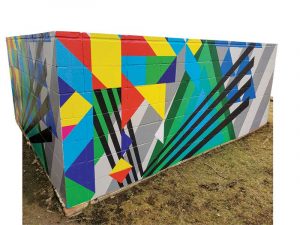Which glue is right for you?
by carly_mchugh | 22 July 2022 3:28 pm
 [1]
[1]By Jay Kroll
We have all done it. It’s the 11th hour on a deadline, materials you were counting on have not arrived and that resourceful, desperate, creative scrambling takes hold. You grab whatever you have available, to get you just close enough to the spec, even though you know you will just have to redo it when the material finally shows up. It is desperation-fueled ingenuity, and it has saved my bacon more than once.
What about when you have plenty of time, but choose to settle for the materials you have on your shop floor? Have you ever tried to force functionality from films you knew weren’t a good fit? Or applied an adhesive, with fingers crossed, hoping it sticks and doesn’t destroy the surface? When we use cast vinyl for bumper stickers or short-term signage, or use an economy vinyl for a car wrap, we’re doing our customers a disservice and likely leaving money on the table.
A lot of this can be blamed on what Charles E. Hummel refers to as the “tyranny of the urgent,” struggling to keep up with the complexities, let alone taking the necessary time, for education on all of the options and moving parts.
As a product manager at General Formulations, it is my job to understand the building blocks of adhesive-backed graphic films and what they can do, both as components and sets. My hope is this quick overview of some of those pieces and parts will help you to make better decisions when you choose material for your next job.
A quick disclaimer: while I prefer working with GF films, the following information is universal for vinyl in the graphics industry. With very few exceptions, adhesive-backed graphic films will incorporate three key components: film, adhesive, and liner. Within those three building blocks, a whole world of chemistries and combinations exist. Let’s dive in with the first building block—film.
For the sake of this article, we are talking about vinyl films. There are two main categories—calendered and cast—and there are different forms of calendered vinyl. All vinyl is essentially the same base ingredients derived from chlorine (salt) and ethylene (oil) with different additives and manufacturing processes.
Calendered vinyl is like pizza dough, heated as a blob of resin and squeezed and stretched to a thin film and rolled up for future processing. It has memory, which is why it tends to shrink over time or when heated. Calendered vinyl gets its texture from the calendaring process, where embossed or ultra-smooth rollers will create the matte or gloss finish, as well as impress details like a canvas or stucco texture.
Monomeric vinyl, otherwise known as economy or promotional vinyl, utilizes a single type of polyvinyl chloride (PVC) resin. This one is typically good for limited applications and is often called “cheap and shiny.” Monomeric films can be great gloss films, but the single resin does not have enough surface area to hold all the additives such as UV stabilizers and plasticizers needed to give flexibility and longevity.
These films are good for short-term or interior applications, but not for projects like vehicle graphics or long-term outdoor signage. These films turn brown and chalky within one to two years outdoors as they do not have the structure to last under extended sun exposure.
 [2]
[2]Polymeric vinyl, also known as intermediate vinyl, uses a mix of several types of PVC resin with a greater surface area for those additives that extend product life or give special performance characteristics. The mix of materials in this construction can increase opacity, flexibility, UV durability, fire resistance, gloss, and so on. This is the category where most specialty vinyl lives, and the applications are vast. Wall graphics, floor films, and even some vehicle and fleet wraps, can all be found in this category.
Cast vinyl is different right from how it is formulated and mixed, starting as a solvated liquid that is poured out onto a paper or film casting sheet, heated to flash off the liquid solvents, and then fused to form a durable, high-performance film. The casting sheet will determine the finish of the film, and typically range all the way from ultra-gloss to ultra-matte. Cast vinyl for the graphics industry do not include any special textures or patterns like you would find in intermediate vinyl. The manufacturing process is much more complex than calendered and results in a material that has incredible stretch and conformability and can be formulated to have extended outdoor durability far beyond the capabilities of its calendered counterpart.
Cast vinyl is typically used for more complex, long-life projects such as fleet graphics or textured wall wraps. However, that film is just one piece of the puzzle, and film by itself can only go so far. For the material to work, it needs the second building block—glue.
When thinking about glue, things like sticky, high-tack, removable, permanent, peel, or bond come to mind. What about opaque, slideable, beaded, or repositionable? Perhaps solvent or water-based? All of these are components that can be designed into an adhesive, and all have applications where they are needed.
First, let’s talk about the difference between tack and bond. Tack is a measure of how much initial or quick-grip an adhesive provides. A high-tack adhesive will stick immediately to a surface it contacts, attempting to anchor to the substrate so it can build bond, or “adhesion over time.” Tack is right now; bond is over time. A low-tack removable adhesive is ideal for window graphics where the higher surface energy of the glass does not require a lot of initial tack for the adhesive to stick, and the removable adhesive ensures low bond for clean and easy replacement of the graphics when the promotion is over.
On the other hand, high-tack permanent adhesives grip and hold and will likely either leave adhesive behind when it is time to change the graphic, damage the substrate, or both. It is designed to adhere strongly right from the start, making it easier to stick to surfaces that otherwise would repel the glue, like low surface energy plastics, textured surfaces, wood, or powder coated metal.
High-tack removable adhesives have an initial grip, which comes in handy when sticking to flat finishes, low volatile organic compounds (VOC) paints, but maintains a low bond allowing the decals to be removed cleanly and easily when it is time to change out a promotion or redo room décor. Similarly, low-tack permanent adhesives, like those found in slideable vehicle wraps, have low initial tack to allow for easier alignment, and then build to a permanent bond with the addition of heat, pressure, and time.
 [3]
[3]All these characteristics can be designed into the product and should all be considered based on the ultimate application surface, projected lifespan, and any special performance requirements.
The final building block in the mix is the liner, which is much more than the shiny piece of paper you throw away at the end of the job. The liner thickness, paper type, and silicone formulation play a vital role in the overall product performance. Manufacturing methods may vary but, generally, the release liner is coated with adhesive, run through an oven to dry/cure the adhesive, and the face film is then laminated prior to winding into a large jumbo roll. Very rarely will the vinyl itself go through the oven, and that has to do with “memory.” Paper or film liner is stable through the adhesive coating process; if coating directly to the vinyl, it would have a tendency to soften, stretch, or shrink, and ultimately end up impossible to work with.
Liner gives a surface to cut against, provides a way to deliver stickers across the world, imparts a pattern to the adhesive to allow for air to escape during installation, and makes it so we can use and reuse removable decals. It is critical for the manufacture of adhesive-coated vinyl, and functional for how we use and install the various flavours of application-specific products. It is a highly engineered, necessary component, even if just thinking of it as the piece that gets thrown away.
So, what if you need to print window graphics for a one-month promotion at a pizza shop? One might use a monomeric or polymeric calendered vinyl, probably a low-tack removable adhesive, and a regular 90# lay flat liner with or without air egress. Cast vinyl would be overkill and using a permanent adhesive on a short-term application should be avoided.
Wall graphics might require something like a polymeric calendered vinyl with an adhesive that is both high-tack and removable, and the slight texture of the painted drywall means no special air egress functionality is needed from the liner. Cast vinyl can be used for wall wraps, but then a laminate needs to be added and it becomes really expensive for a job with less expensive vinyl options specifically designed for it.
Cut vinyl lettering for a shop window that needs to last three to five years could use a polymeric vinyl, permanent adhesive, and a 78# liner for better performance and finer detail with the cutting equipment.
These three building blocks working together—film, adhesive, and liner—represent a world of possibilities in the graphics industry. Knowing the options and materials will help to decipher the pieces and parts and allow for the right combination for the application. The goal is to understand what one is working with and be able to know “which glue is right for you” without reprints, rework, or guessing, and to ultimately be the expert for the customers to guarantee repeat business and quality work every time.
Jay Kroll is a product manager at General Formulations, a leading manufacturer of pressure-sensitive solutions for the graphics industry. His focus is on cut vinyl, transit, and wall graphic applications. He has been designing and developing various manufactured solutions for more than 20 years in the medical, aerospace, specialty tape, and graphics industries.
- [Image]: https://www.signmedia.ca/wp-content/uploads/2022/12/GF-280-WindowMark-Perforated-Window-Film.jpg
- [Image]: https://www.signmedia.ca/wp-content/uploads/2022/12/GF-226-WallMark_D4U-Printing.jpg
- [Image]: https://www.signmedia.ca/wp-content/uploads/2022/12/GF-285-RoughMark_SpeedPro_-Calgary_3.jpg
Source URL: https://www.signmedia.ca/which-glue-right-for-you/